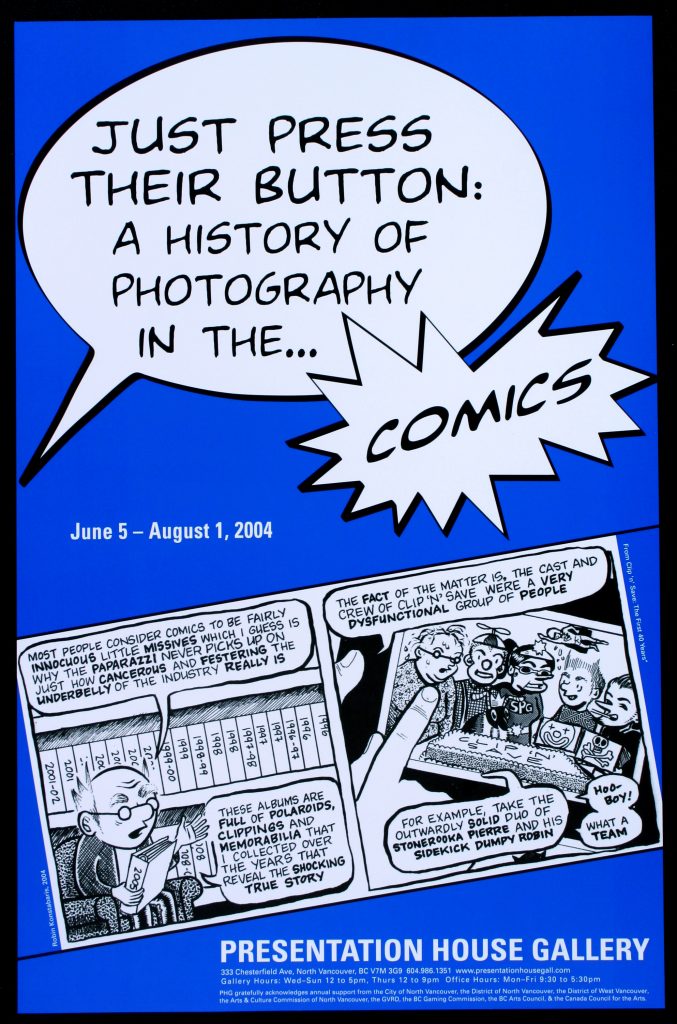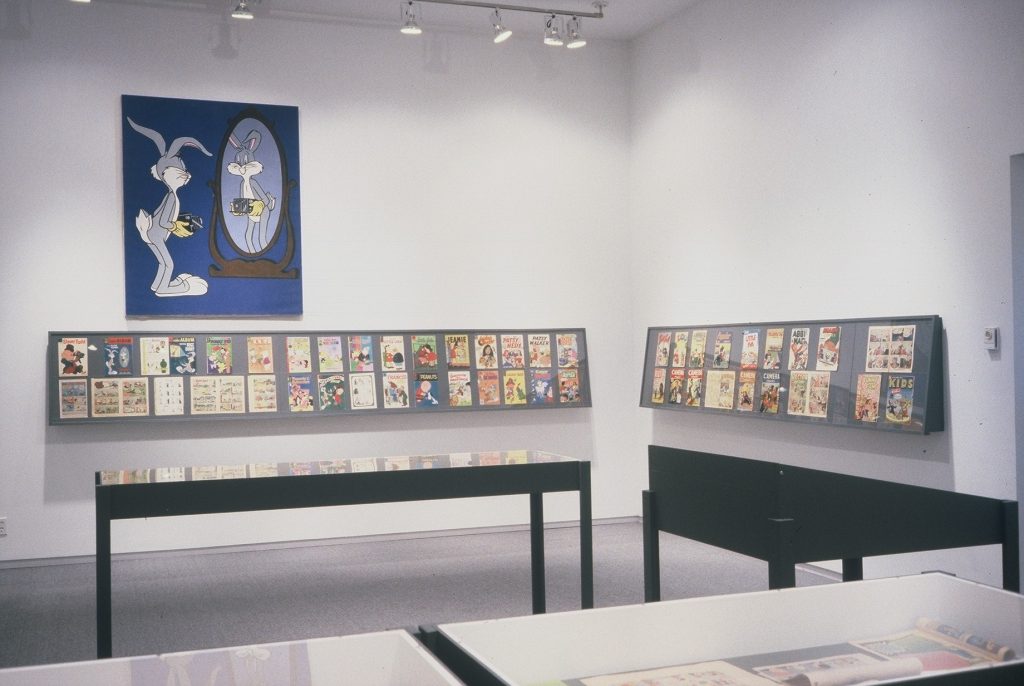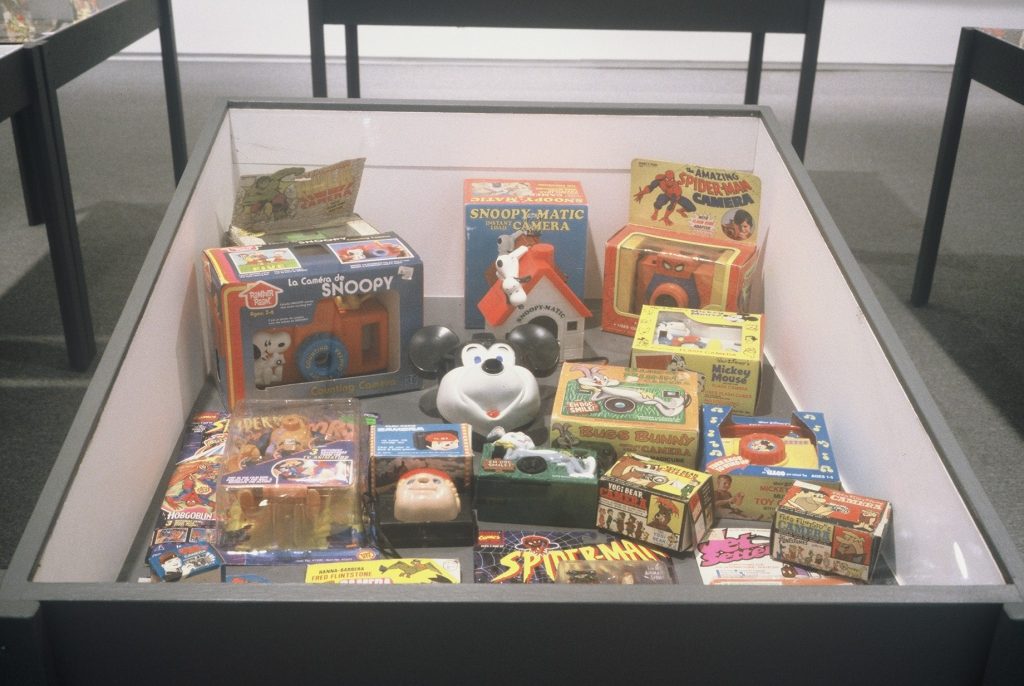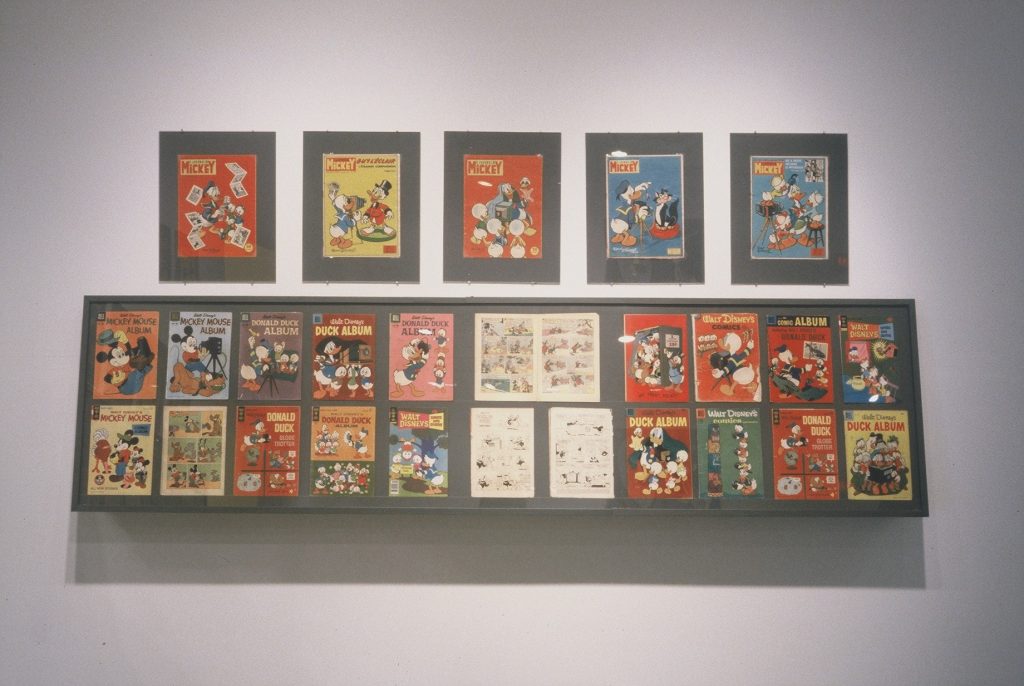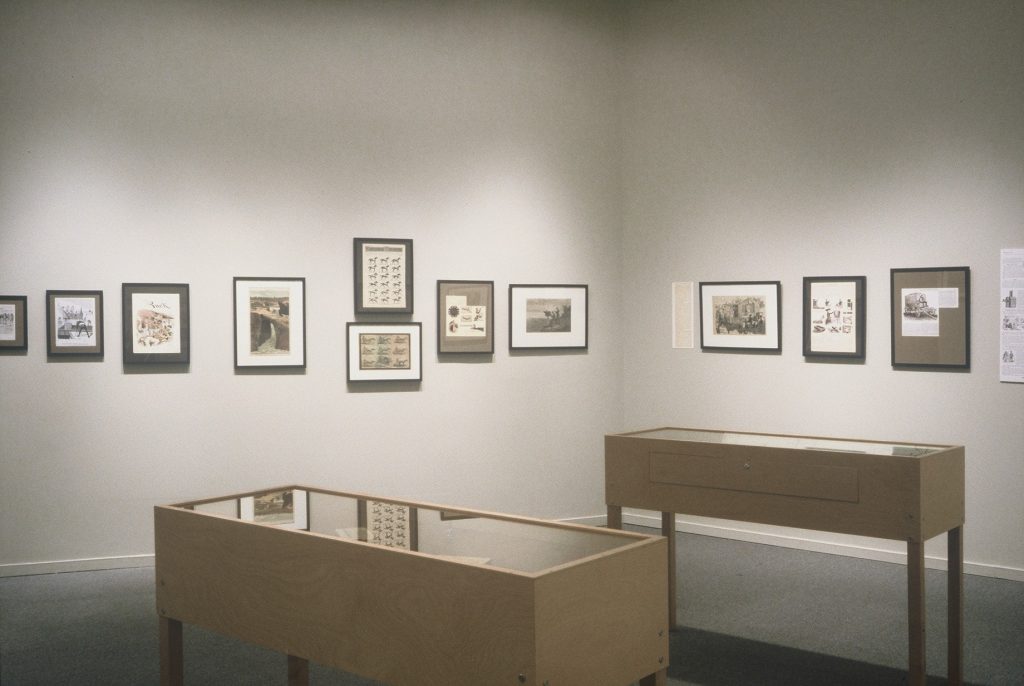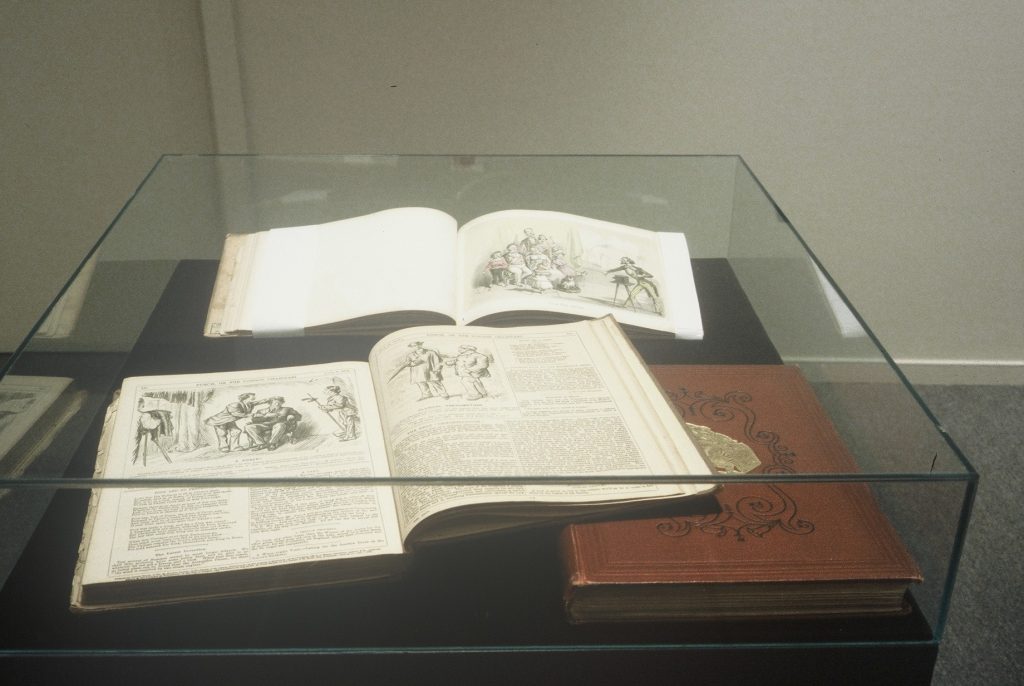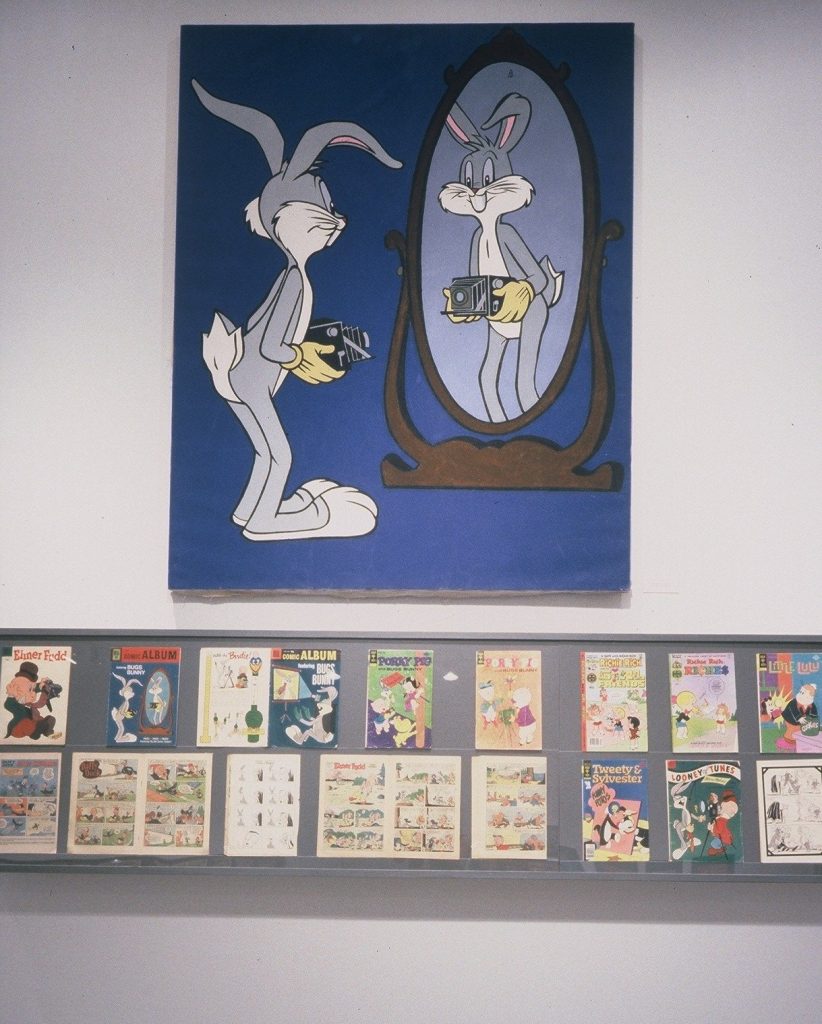Just Press Their Button: A History Of Photography In The Comics
Curated by Bill Jeffries
The Just Press Their Button exhibition is comprised of three separate but related parts. This room has original comics artwork by three Vancouver artists, David Boswell, Robin Konstabaris and Colin Upton. The comics by Robin Konstabaris and Colin Upton were especially created for this exhibition. David Boswell’s ‘pages’ are taken from chapters in the life of Reid Fleming, World’s Toughest Milkman that he has been creating over the past twenty-plus years. The east room contains pre-comics graphic material, mainly from the 19th century, depicting the trials and tribulations of photographers and their subjects in the first sixty years after photography’s invention. The west room contains examples of comics that depict cameras and photographs in the lives of comics characters, and those characters operating as photographers. The origin of this exhibition lies in an article that Vancouver photographer Denes Devenyi published in the August 1989 issue of Photo Life magazine. In that article Devenyi explored not only the wide range of photo-related material in comics history, but introduced a key idea raised by this exhibition – that photography’s popularity might rest, in part, on its depiction in the comics.
Comics have been analyzed in many ways and the value systems that they portray are as varied as life itself. And life itself has again become a key topic, not only in Vancouver comics art, but in the work of thousands of comics artists around the world. The past decade has seen an explosion of interest in comics and several large exhibitions have been devoted to the influence of comics on contemporary art, including the Comic Release exhibition that has just ended its run in Bellingham. This upsurge of interest has involved cinema, such as the film of the graphic novel Ghost World and the biographical documentary on the life of comics artist Harvey Pekar depicted in the film American Splendor. Theorists have explored many facets of comics culture over the past thirty years, probing everything from the impact of commercialism in mainstream comics to the nature of gender roles as portrayed in publications that are often intended for young people. However, even with all the attention recently given to the various subject areas within the comics, it would appear that the pervasive presence of photography in the comics has never previously been explored in an exhibition.
This exhibition’s title borrows Kodak’s marketing phraseology – “you press the button, we do the rest” was Kodak’s sales pitch starting in the late 19th century. Was the marketing of cameras to young people a business experiment in which the pleasures of image reproduction became a seductive and easily achievable activity for “the whole family”? Just by ‘pressing a button’ photographic magic could be achieved and by removing the messy chemical procedures that photographers had to contend with, Kodak began the process of selling consumers on appliances that “did the work for you”. The complexity of the relation between comics and photography stems in part from the ways the two forms have influenced each other. Kodak may have started the current phase of this interaction by “pressing our collective button” through its marketing efforts, but the commentary on photography clearly began as early as the 1840s.
Comics art, however defined, can be argued to have existed for many centuries if we accept that picture-stories have been around since at least Hogarth’s time and much longer if we include narratives in, to take one example, Mayan codices and sculpture. The definition of ‘comics’ proposed by Scott McCloud in his Understanding Comics is concise and to the point: “Juxtaposed pictorial and other images in deliberate sequence, intended to convey information and/or to produce an aesthetic response in the viewer.” McCloud proposes that we call single panel comics such as The Far Side or comic book covers, “cartoons” or “comic art” and reserve “comics” for sequential material.
Whether the case can be made that ‘photography in the comics’ established the normalcy of ‘picture taking’ for generations of youth remains to be seen. What is somewhat surprising is the frequency with which cameras, photographers and photographs in photo albums appear in the history of comics. It might be stretching it to say that the camera was a comics’ ‘superhero’, but photography was certainly seen as a ‘super tool’ in comics, not only for expected uses such as surveillance, but also as a ‘product’ conveniently ‘placed’ with comics characters, thereby becoming a normal component of their lives, as it is of ours.
The idea that comics can have an impact on society is taken for granted now, especially with the extraordinary presence that ‘anime’ and ‘manga’ have had in Japanese culture. If comics art has become a universe parallel to our own it should come as no surprise that most of our preoccupations make an appearance in the comics, just as photography clearly has. Comics help us to suspend disbelief, not only when action heroes accomplish impossible feats, but also when we see our favourite anthropomorphised animal characters from childhood, such as Donald Duck, manage their cameras with either consummate skill or fall prey to hilarious ‘photographic’ gaffes. The ‘toy’ cameras shown here, beginning with the Brownies from around 1905, seem to be using comics characters to sell a product, but looking at them one has to wonder if the comics are not in fact also promoting a medium. Photography is a medium capable of mirroring the world back to us in myriad ways, as well as a practice capable of being taken seriously or lightly; here it is mirrored back to viewers as a wide-ranging cultural phenomenon. This graphic commentary ‘on photography’ in the comics presents an alternate, and very subjective history of the reception of the medium that is the core of this gallery’s mandate.
Gallery Press Release
Events
Sunday June 5, 2 pm: | An introduction to the exhibition by PHG Director Bill Jeffries with a special presentation by Denes Devenyi, whose 1989 article in the magazine Photo Life, was the inspiration for this exhibition.
Friday June 10, 8 pm | Panel discussion exploring the role of photography in the comics, moderated by CITR's Robin Fisher, with David Boswell, Robin Konstabaris and Colin Upton.
Touring Exhibition
Art Gallery of South Okanagan, Penticton - March 11 - May 8, 2005
